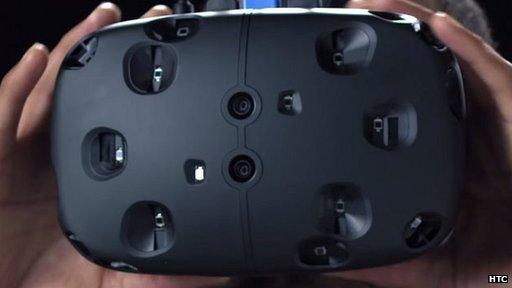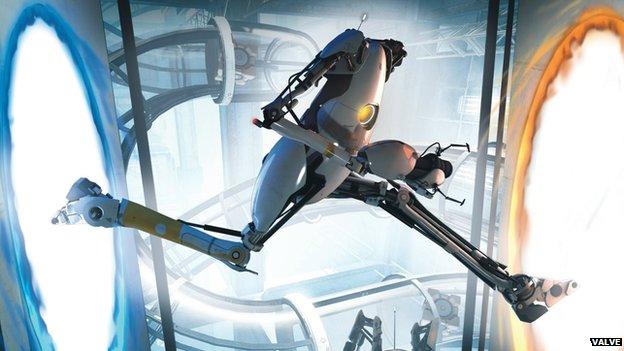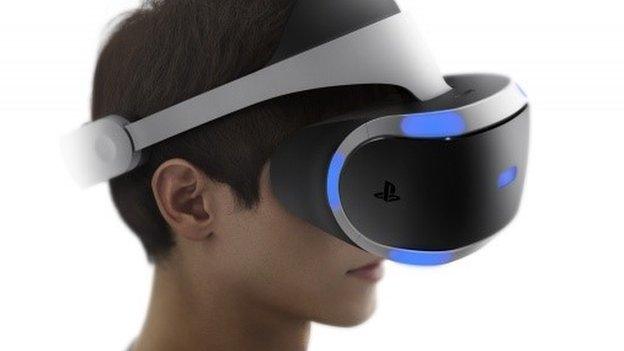Hands-on with HTC's VR headset Vive - can it compete?
- Published

HTC's virtual reality headset uses dozens of sensors to track the wearer's position
In a back room at Mobile World Congress, a select few reporters were offered the chance to try out HTC's unexpected new product - its virtual reality headset, Vive.
Normally we like to offer a video hands-on here on the BBC website, but unfortunately HTC wouldn't allow our cameras into the demo room. So instead, here's an attempt at describing the "indescribable" experience. Bear with me.
The Vive enters a virtual reality market that has been threatening to take off for decades, but with often dire results.
My first experience was at the now-closed Sega World off London's Leicester Square - a huge headset that was far too heavy for my 10 year-old head.
Sixteen years later, in 2013, I'd find myself in the corner of Showstoppers, a fringe event of the enormous Consumer Electronics Show in Las Vegas. It was here I tried on an Oculus Rift, held together with sticky tape, for around 10 minutes.
I was sold. I'd have bought it then, had Oculus been selling it.
The company has sold itself - to Facebook last year, for a blistering $2bn (£1.2bn) - but as yet, no product on the shelves.
In 2014, Sony entered the fray with its effort, Project Morpheus. Yesterday, the company said it planned to release it in early 2016.
'Indescribable'
One company that wants to beat them to it is HTC. At Mobile World Congress, they surprised many be launching Vive, its own VR headset which it has worked on in collaboration with Valve, the games maker behind huge titles such as Portal and Half-life.
HTC has promised its release by the end of this year. In a backroom at Mobile World Congress, a select number of journalists were given a try-out of the technology.
Dave Lee gets an early reaction to HTC's VR kit
As I was taken into a fairly large, mostly-empty room, it became immediately apparent why they didn't want the cameras in. HTC has promised a 2015 release date, but Vive isn't quite ready yet - cables were sprawled across the floor and two hand-held controllers had wires dangling from them. Eventually it will all be wireless, my guide told me.
The headset is light enough to be comfortable for a long time providing your eyes can take it. The hand-held controllers resemble the Nintendo Wii nun-chuck configuration - independent from each other physically, but interacting in the virtual world, usually as your hands.
The controllers had several inputs: a trigger on the reverse, a track pad on top for your thumb, and two grip sensors on each side, meaning you can apply different levels of squeezing.
Vive's innovation in VR is the ability to walk around the room while wearing the headset. I was - understandably, I'd argue - very apprehensive about this. This room had walls. Hard walls.
But to deal with this, the software applies an intelligent grid system. If you walk too close to a wall or obstacle it will gradually appear to warn you. Unless you're in impending danger, you won't see the grid, meaning the immersive experience isn't spoilt. After a short while, my confidence in this grid system grew to a point where I was confident in jumping around.
Kitchen sink
The first demo was on a ship-wreck - I was able to walk around the ship's tattered deck. By taking a couple of (real) steps forward, I could peer over the edge. A whale swam by, and I was able to interact with the little fish swimming around by swishing them with my virtual hands.

A VR version of Valve's classic Portal series was part of the demo
The next demo was perhaps the most impressive when it came to interaction. It was a kitchen scene, with food and utensils. Determined to see if I could catch the software out, I picked up a rolling pin and threw it across the room. It flew off - hitting a pan hanging from a hook before clattering to the ground. Then I found a ball of dough... and hit down on it with my virtual fist, and it promptly flattened.
At one point I dropped a knife and instinctively hopped out the way before picking it up. My guide laughed - I wasn't the only person who was instinctively keen to keep the virtual kitchen tidy.
Next - a battle scene. The point here wasn't to interact, but observe. I was an invisible giant, and I could stand up and see an entire battlefield with arrows and cannon balls flying. Or, I could crouch down and peer closely at each individual soldier, with remarkable attention to detail.
Finally, a VR version of the Portal series. It was here the true capability of this system was apparent. I was in a small room carrying out a robot repair requiring intricate movements - but before long I found myself in a huge warehouse where I could see well into the distance.
Injury
HTC may have been a surprise entrant into this sector, but it is now a major player, perhaps even a frontrunner.
But there are weaknesses. Taking the headset off was a relief, the straining effect it has on your eyes is concerning - but this is a pitfall with which all VR headsets suffer.
Dave Lee shows off some of the latest VR headsets
Also, despite the clever grid system warning you of obstacles, I think in the heat of the moment, or during a particularly scary game, you'd still run away, injuring yourself, perhaps seriously. Over the years we've heard many anecdotes about people injuring themselves with the Nintendo Wii - this brings the potential for harm up by several levels.
Which leads me to wonder - perhaps the ideal place to truly enjoy high-end gaming won't be in the home.
The experience delivered by the Vive, and others like it, would be greatly enhanced if enjoyed in a large room with padded walls. Only then could you be truly transported to another world without worrying about tripping over the cat.
It could see the reinvention of the games arcade. Or maybe your spare room will soon be your home's virtual reality zone.
Follow Dave Lee on Twitter @DaveLeeBBC, external
- Published4 March 2015

- Published3 March 2015

- Published3 March 2015
